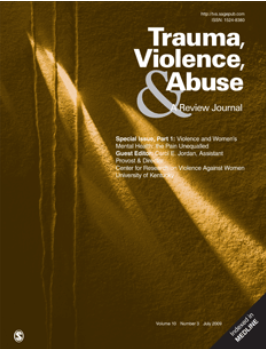Depression Symptom Trajectories Following Child Maltreatment: A Systematic Review of Longitudinal Studies from Adolescence to Young Adulthood.
IF 5.4
1区 社会学
Q1 CRIMINOLOGY & PENOLOGY
引用次数: 0
Abstract
Previous reviews suggest that child maltreatment results in worse depression symptoms during adolescence and young adulthood. However, less is known about how depression symptoms evolve throughout this critical period. This systematic review evaluates changes in depression following child maltreatment and identifies factors influencing this relationship from adolescence to young adulthood. A search of APA PsycINFO, CINAHL, Embase, and Medline until January 13, 2023, found 87 studies from 31,495 records. Studies were included if they examined child maltreatment's effect on depression symptoms for individuals aged 0 to 24, assessed child maltreatment or abuse, and neglect subtypes, measured depression diagnosis or symptoms at a subsequent time point, and used quantitative longitudinal or cohort designs. Of the studies meeting criteria, only 13 examined depression symptom changes, with mixed results found. Most studies identified severe and worsening depression symptom trends, as shown in both linear and nonlinear depression symptom studies. Other studies examined distinct patterns of depression symptom severity within a single sample (e.g., high vs. low symptom trends) and observed some improvements over time, suggesting the influence of protective factors. However, across all studies, depression symptoms remained relatively worse than in individuals without child maltreatment histories. One-third of studies explored factors influencing depression symptom change, primarily focusing on intrapersonal and interpersonal factors, though findings were inconsistent. A smaller subset investigated environmental factors, demonstrating that school-related aspects consistently impacted the relationship. Findings highlight the importance of early detection and timely intervention through continuous screening to improve depression outcomes for adolescents with child maltreatment histories.儿童虐待后的抑郁症状轨迹:从青春期到青年期的纵向研究的系统回顾。
以前的研究表明,儿童虐待会导致青少年和青年期的抑郁症状加重。然而,在这一关键时期,抑郁症症状是如何演变的,我们所知甚少。本系统综述评估了儿童虐待后抑郁症的变化,并确定了从青春期到成年早期影响这种关系的因素。到2023年1月13日,在APA PsycINFO、CINAHL、Embase和Medline上搜索,从31495条记录中发现了87项研究。如果研究检查了儿童虐待对0至24岁个体抑郁症状的影响,评估了儿童虐待或虐待和忽视亚型,测量了随后时间点的抑郁诊断或症状,并使用定量纵向或队列设计,则将研究纳入其中。在符合标准的研究中,只有13项研究检查了抑郁症状的变化,结果好坏参半。大多数研究确定了严重和恶化的抑郁症状趋势,线性和非线性抑郁症状研究都显示了这一点。其他研究在单个样本中检查了抑郁症状严重程度的不同模式(例如,高与低症状趋势),并观察到随着时间的推移有所改善,这表明保护因素的影响。然而,在所有的研究中,抑郁症状仍然比没有儿童虐待史的人相对更严重。三分之一的研究探讨了影响抑郁症状改变的因素,主要集中在个人和人际因素上,但研究结果并不一致。一个较小的子集调查了环境因素,表明与学校有关的方面一直影响着这种关系。研究结果强调了早期发现和及时干预的重要性,通过持续筛查来改善有儿童虐待史的青少年的抑郁结果。
本文章由计算机程序翻译,如有差异,请以英文原文为准。
求助全文
约1分钟内获得全文
求助全文
来源期刊

Trauma Violence & Abuse
Multiple-
CiteScore
13.60
自引率
7.80%
发文量
131
期刊介绍:
Trauma, Violence, & Abuse is devoted to organizing, synthesizing, and expanding knowledge on all force of trauma, abuse, and violence. This peer-reviewed journal is practitioner oriented and will publish only reviews of research, conceptual or theoretical articles, and law review articles. Trauma, Violence, & Abuse is dedicated to professionals and advanced students in clinical training who work with any form of trauma, abuse, and violence. It is intended to compile knowledge that clearly affects practice, policy, and research.
 求助内容:
求助内容: 应助结果提醒方式:
应助结果提醒方式:


